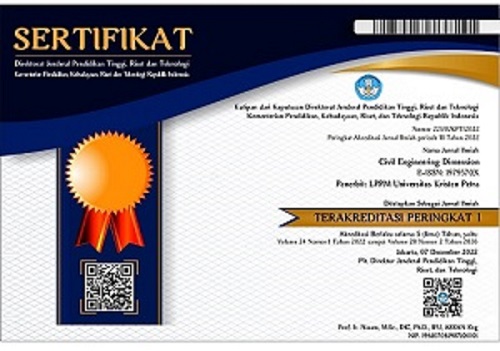Evaluation of ASTM D 1143/D 1143M-07 and Chinese Code JGJ 106-2014 for Pile Load Testing using Finite Element Method
 :
:
https://doi.org/10.9744/ced.25.2.126-134
Keywords:
Static loading test, ASTM D 1143/D 1143M-07, Chinese Code JGJ 106-2014, Finite Element Method, Load–settlement curveAbstract
Pile foundation is a structural element utilized to transmit structural load into the soil mass. During design processes, many empirical equations used to estimate axial pile capacity, and a pile load test is conducted to validate the design. In Indonesia, it is common to adopt ASTM D 1143/D 1143M-07 for pile testing. Chinese Code JGJ 106-2014 is another viable option, which has gained popularity recently. This study investigated the load–settlement curves obtained using both codes. The analyses were simulated using the Mohr–Coulomb and the Hardening Soil models. The Hardening Soil model yielded more reasonable load–settlement and load–excess pore water pressure curves than the Mohr–Coulomb model. The reason due to the Mohr–Coulomb model unable to capture the non-linear behavior of soil properly. Furthermore, the results showed that ASTM D 1143/D 1143M-07 and JGJ 106-2014 yielded comparable results. Hence, both methods could be substituted each other.
References
ASTM D1143 / D1143M-07, Standard Test Methods for Deep Foundations Under Static Axial Compressive Load, ASTM International, 2007.
JGJ 106-2014, Technical Code for Testing of Building Foundation Piles. Ministry of Housing and Urban-Rural Development of the People’s Republic of China, 2014.
Teshager, D.K., Numerical Simulation of Static Pile Load Test on Stratified Soil Deposits, Global Scientific Journal, 7 (11), 2019, pp. 1180–1211.
Krasiński, A. and Wiszniewski, M., Static Load Test on Instrumented Pile-Field Data and Numerical Simulations. Studia Geotechnica et Mechanica, 39(3), 2017, pp. 17–25. https://doi.org/10.1515/sgem-2017-0026
Schanz, T., Vermeer, P.A. and Bonnier, P.G., The hardening-soil model: Formulation and verification., In Proceedings of The International Symposium Beyond 2000 in Computational Geotechnics, Amsterdam, the Netherlands, March 18-20, 1999, pp. 281–290. https://doi.org/10.1201/9781315138206-27
Yi, L. Finite Element Study on Static Pile Load Testing. Master’s thesis, National University of Singapore, 2004.
Yang, M. and Liu, S., Field Tests and Finite Element Modeling of a Prestressed Concrete Pipe Pile-Composite Foundatio, KCSE Journal of Civil Engineering, 19(7), 2015, pp. 2067–2074. https://doi.org/10.1007/S12205-015-0549-Z
Abdel-Azim, O.A., Abdel-Rahman, K., and El-Mossallamy, Y.M., Numerical Investigation of Optimized Piled Raft Foundation for High-Rise Building in Germany, Innovative Infrastructure Solutions, Springer, 5(1), 2020. https://doi.org/10.1007/s41062-019-0258-4
Haouari, H. and Bouafia, A.A., Centrifuge Modelling and Finite Element Analysis of Laterally Loaded Single Piles in Sand with Focus on P–Y Curves. Periodica Polytechnica Civil Engineering, 64 (4), 2020, pp.1064–1074. https://doi.org/10.3311/PPci.14472
Knappett, J.A. and Madabhushi, S.P.G., Modelling of liquefaction-induced instability in pile groups. In Seismic Performance and Simulation of Pile Foundations in Liquefied and Laterally Spreading Ground (Geotechnical Special Publication (GSP) No. 145) (eds. R. W. Boulanger and K. Tokimatsu), ASCE, 2005, pp. 225–267. https://doi.org/10.1061/40822(184)21
Brinkgreve, R.B.J., Witasse, R.P.B., Risques associés à l’utilisation de la méthode des éléments finis pour la géotechnique, Revue Française de Géotechnique, 140–141, 2012, pp. 11–19. https://doi.org/10.1051/geotech/2012140011
Lim, A., Ou, C.Y., Stress paths in deep excavations under undrained conditions and its influence on deformation analysis. Tunnelling and Underground Space Technology, 63, 2017, pp. 118-132
Lim, A., Ou, C.Y., Hsieh, P.G., Evaluation of Clay Constitutive Models for Analysis of Deep Excavation Under Undrained Conditions, Journal of GeoEngineering, 5(1), 2010, pp. 9-20
Lyman, R.A., Lim, A., Rahardjo, P.P., Estimating System Stiffness of Soil Nailing Wall for Deep Excavation in Clay, International Journal of Civil Engineering, Springer International Publishing, 20(9), 2022, pp. 1009-1025
Terzaghi, K. and Peck, R.B, Soil Mechanics in Engineering Practice, Second Edition. John Wiley & Sons, Inc, 1967.
Jamiolkowski, M., Lancellotta, R., Pasqualini, E., Marchetti, S., and Nova, R., Design parameters for soft clays: General Report, In Proceedings of the 7th European Conference on Soil Mechanics and Foundation Engineering, Brighton, England, 5, 1979, pp. 27–57.
Coduto, D.P., Foundation Design: Principles and Practices, Second Edition, Prentice-Hall, New Jersey, 2001.
Look, B.G. Handbook of Geotechnical Investigation and Design Tables. Taylor & Francis, London, 2007.
Das, B.M., Advanced Soil Mechanics, Third Edition, Taylor & Francis, New York, 2008.
Das, B.M., Principles of Foundation Engineering, Eighth Edition, Cengage Learning, Boston, 2014.
Meyerhof, G.G. Bearing capacity and settlement of pile foundations, Journal of Geotechnical and Environmental Engineering, ASCE, 102(GT3), 1976, pp. 197-228.
Tomlinson, M., and Woodward, J. Pile design and construction practice, Fifth edition, Taylor & Francis, London, 2008.
Lim, A., Batistuta, V.H., and Wijaya, Y.V.C., Finite Element Modelling of Prestressed Concrete Piles inf Soft Soils, Case Study: Northern Jakarta, Indonesia, Journal of the Civil Engineering Forum, 8(1), 2023, 21-30. https://doi.org/10.22146/jcef.3597
Saptyanto, K., Hitung Balik Nilai Kekakuan Tanah dari Hasil Pile Loading Test dengan Menggunakan Program Plaxis, Skripsi, Universitas Bina Nusantara, 2012.
Rahardjo, P.P., Manual Pondasi Tiang Edisi ke-5, Geotechnical Engineering Center, Bandung, 2017.
Liao, S.S.C. and Whitman, R.V., Overburden Correction Factors for SPT in Sand, Journal of Geotechnical Engineering, 112(3), 1986, pp. 373–377. https://doi.org/10.1061/(ASCE)0733-9410(1986)112:3(373)
Downloads
Published
How to Cite
Issue
Section
License
Copyright (c) 2023 Aswin Lim, Octavianus Arvin Sukiwan

This work is licensed under a Creative Commons Attribution 4.0 International License.
Authors who publish with this journal agree to the following terms:- Authors retain the copyright and publishing right, and grant the journal right of first publication with the work simultaneously licensed under a Creative Commons Attribution License that allows others to share the work with an acknowledgement of the work's authorship and initial publication in this journal.
- Authors are able to enter into separate, additional contractual arrangements for the non-exclusive distribution of the journal's published version of the work (e.g., post it to an institutional repository or publish it in a book), with an acknowledgement of its initial publication in this journal.
- Authors are permitted and encouraged to post their work online (e.g., in institutional repositories or on their website) followingthe publication of the article, as it can lead to productive exchanges, as well as earlier and greater citation of published work (See The Effect of Open Access).

















